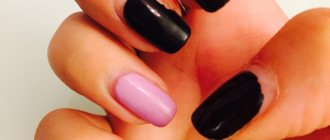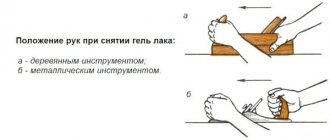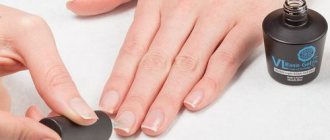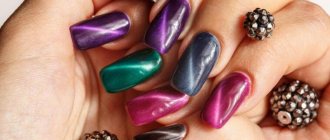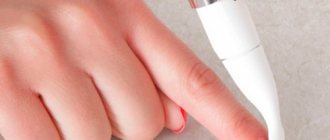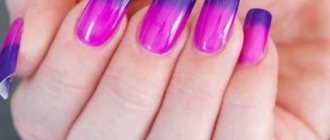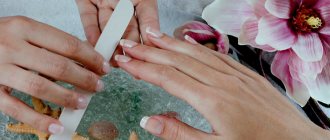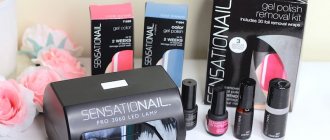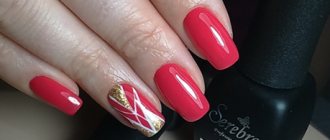Professionals in the nail industry, having once used hardware removal of gel polish, realized that their lives were changing for the better. The advantages of this method are obvious - saving time and space, client safety, absence of aggressive chemical liquids - speak for themselves. This procedure requires a special device - a milling cutter, into which various attachments (cutters) are inserted.
Milling cutter attachments
In this way, you can not only remove the varnish coating, but also process the cuticles, form an even, smooth nail surface, and remove chips and cracks. For all these works, there is a set of nozzles, different in shape, degree of rigidity and rotation speed. Let's figure out how to remove gel polish with a manicure machine at home. What rules must be followed in order to properly remove varnish using a router? Let's find out all the nuances of this process.
Milling cutters and router
The safety and effectiveness of the hardware nail polish removal procedure depends, first of all, on the power and speed of the router, as well as on the material of the nozzles.

Fraser device
The power of universal machines usually ranges from 30,000 to 100,000 watts, and the rotation speed can reach 45,000 rpm. What types of attachments are there, what are they made of, which one is better to choose?
Let's look at this important question. Milling cutters (nozzles) are:
- ceramic are the best attachments. Hypoallergenic, very durable, heat resistant. They work softly, without vibration, have a long service life, can also be used for processing cuticles and barrels;
- steel cutters are used to carefully remove dead skin from cuticles and are usually effectively used in pedicures;
- Carbide attachments (cutters) consist of hard metal alloys and are used for correcting nail plates and treating extended nails. If the gel polish is thick, you can also remove it with these cutters (down to the base). There is no dust during processing; this attachment only forms chips. The rotation speed can reach 30-40 thousand revolutions, as a result there is no heating;
- cotton and silicone. Soft cutters for polishing plates at the end of the procedure, to level the surface and add shine. They are not used to remove gel polish;
- diamond cutters. Suitable for processing cuticles and forming the desired contour and length of nails, creating acrylic nail designs.
Obviously, the innovative ceramic cutter is the best attachment for removing gel polish.

Removing white gel polish
Which cutter should I use to remove gel polish?
Today, when you go to a manicure store, you will see 2 types of cutters for removing gel polish:
- carbide (metal);
- ceramic.
Let's figure out what their features are.
Carbide (metal) cutters are made from hard metals. They have an oblique, straight or cross-shaped notch. When working, they turn the material into small chips, not dust. Keep in mind that when working with plastic materials (for example, gel), it is better to use metal cutters with fairly large notches, otherwise the material will soon clog the cutter.
Carbide cutter corn green/red STF
Carbide cutter 406801 Coarse grain green STF
Carbide cutter 509801 Very coarse cut/Super coarse grit, black STF
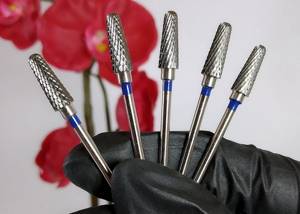
Ceramic cutters are made from ceramics with a very complex composition. It includes special clay substances, feldspar, quartz, and bone ash. As a result, after firing, an incredibly durable material is obtained. Its wear resistance is much higher than that of carbide, so ceramic cutters last 3-4 times longer than metal ones. Another advantage of ceramics is its high heat resistance. Such cutters do not heat up during operation.
Ceramic flame cutter (05 blue) IRISK
Ceramic cutter corn red ParisNail
Ceramic cutter black corn blue-red
Thanks to their high cutting capacity, ceramic cutters cut material very gently, almost without vibration. They do not get clogged during the process of removing gel polish, as they turn it into dust rather than chips. But this advantage is also a disadvantage, since dust floats in the air and settles on the surface. To avoid negative effects on health, you must ALWAYS use a manicure vacuum cleaner or a built-in hood.
Hood 4BLANC Alize
Manicure dust collector with pillow (metal, white) ND-PRO 80W ParisNail
Of course, all the advantages of ceramic cutters affect their cost - it is much higher than that of carbide cutters. But they will also last much longer.
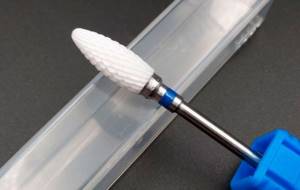
INTERESTING FACT! A master working without a hood or vacuum cleaner inhales approximately 1 teaspoon of dust, which consists of microscopic particles of nail polish and nails, in just 1 working day.
Recruitment of a specialist
What you need to remove gel polish with a manicure machine:
- router and attachments (cutters);
- brush for cleaning dust and chips;
- orange wood sticks (you can use a scraper);
- cotton pads or smooth napkins;
- face mask against dust and shavings;
- regular nail file;
- buff for polishing;
- warm oil to soften and nourish nails and cuticles.
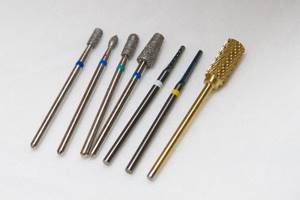
Set of nozzles
After removal
When gel polish is removed, your nails need rest and proper care to recover. The following procedures are needed:

You can use a special transparent varnish, which is sold at the pharmacy. It is intended for the care and restoration of the nail plate.
All stages
Let’s take a closer look at how to properly remove gel polish with a device:
- prepare the necessary attachments;
- wash your hands, dry them, especially your nails;
- use an orange stick or scraper to move the cuticles as far as possible from the nail plate;
- set the cutter speed to approximately 20,000;
- use long, smooth movements to remove the polish from the main part of the plate in the direction from the cuticle to the cut of the nail, holding the nozzle parallel to the surface of the plate;
- treat the area near the cuticles and side ridges with the end of the cutter;
- remove only the layer of colored varnish up to the base;
- treat the main area of the plate with a hard cutter, in the cuticle area - with a softer one;
- brush off gel dust and shavings;
- incompletely processed areas should be finished with a soft milling cutter;
- polish the nail plates with a buff to form an even, smooth surface;
- rub in warm oil to soften and nourish the plates;
- polish the plates with a piece of suede cloth.
Simplification of the procedure
Before manicure, nails should be dried so that there is less oil on them. If this step is skipped, or you decide to apply it specifically before the procedure, then removing the gel polish will be much easier. But the coating will not last long. This procedure will eliminate the gel without a special liquid. You can also easily remove the coating with an exfoliating base layer. This is ideal for those who need a manicure for a week. After a few days the varnish chips off.
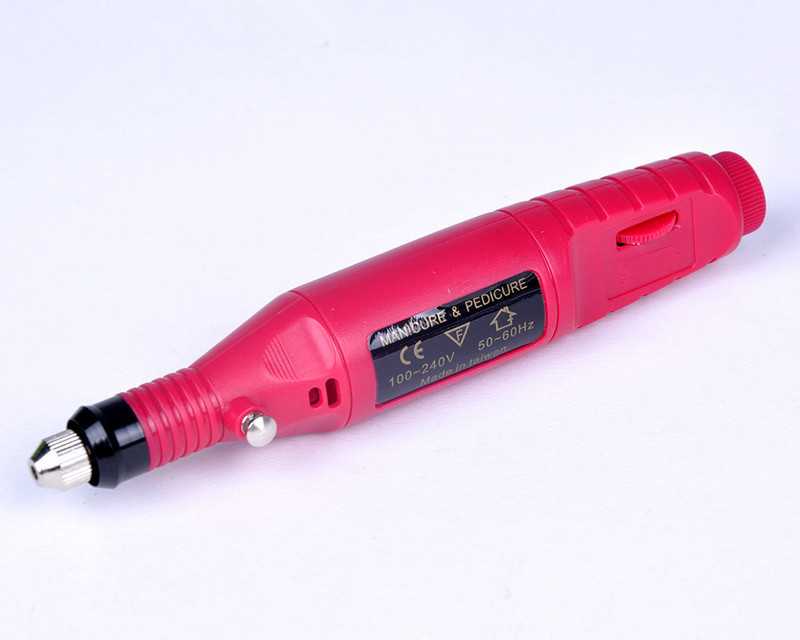
Useful tips
To obtain an effective result, you must consider the following recommendations:
- the procedure must be performed slowly, carefully and carefully;
- the hand with the cutter must be firmly fixed in a stationary position;
- Do not put pressure on the nails with the nozzle, only touch and slide over the surface so as not to damage the plate;
- the rotating cutter cannot be kept in one place; it must be constantly moved along the surface of the nail;
- You should be careful when touching areas close to the skin;
- It is advisable to work with the cutter wearing a mask, otherwise dust may get into your lungs.
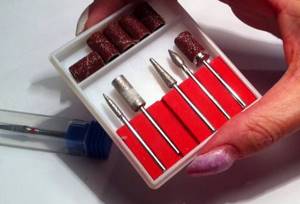
Set of nozzles
Operating principle of the device
A device with many attachments, which is used to perform hardware manicure and pedicure, is obedient only in the hands of a master, therefore, without special skills, it is better to buy a simpler device for home use.
The standard device consists of:
- housings with a handle attached to it or a separate handle;
- electric motor with speed controller;
- compartment for batteries or power supply (or both);
- set of nozzles.
The motor rotates the nozzle, which performs a function assigned to it at a certain speed: exfoliates dead skin, removes cuticles or files nails.
Reasons for popularity
This new method - removing gel polish with a manicure machine has become popular for many reasons, we will indicate some of them:
- saving time;
- does not damage the nail plate, there are no aggressive substances;
- the nozzle does not come into contact with the nail plate (the color layer is removed down to the base);
- a cutter operating at high speed does not cause discomfort;
- when held correctly in the hand, it removes the polish very delicately, without touching the nail plate itself;
- dust from filing can be eliminated if you have a vacuum cleaner for manicure.
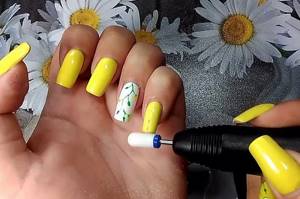
Removing gel polish with a milling cutter
Some features should be noted:
- the presence of small chips is harmful to breathing, you must use a mask;
- it is necessary to purchase a device and a set of attachments, clean and replace it;
- practice is required to work confidently and safely with a router;
- cannot be used in case of individual intolerance, allergies to dust, or thinned plates.
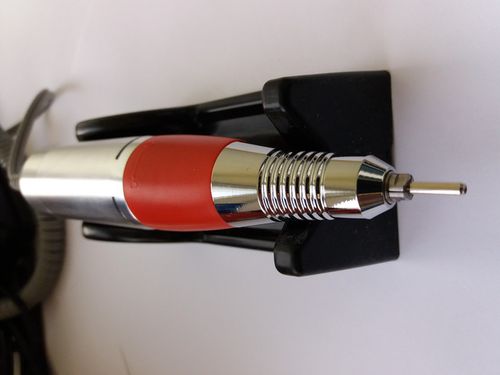
Fraser device
Don't forget about safety rules!
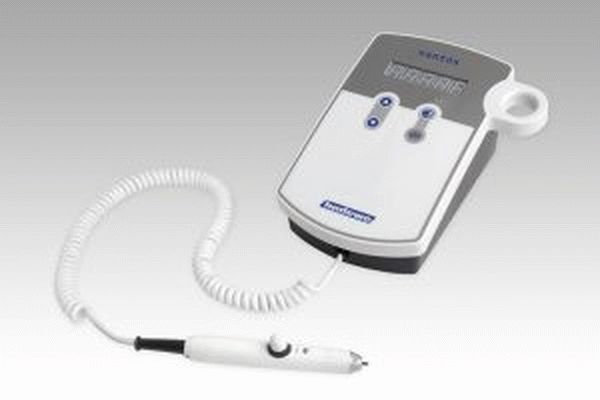
Following a few simple rules completely eliminates the possibility of injury during hardware removal of gel polish from nails:
- Before starting work, it is necessary to inspect the device; if there is damage, it is prohibited to turn it on;
- the nozzle is inserted all the way and only when the device is turned off;
- the master’s elbow must be on the table in a position that excludes uncontrolled movements;
- The cutter can rotate both to the right and to the left. To prevent it from slipping off the nail unexpectedly, the artist’s movements should always be synchronous with the direction of travel of the working nozzle;
- when trying to reach inconvenient places, you do not need to turn the cutter too much, it is better to do this with your finger;
- when removing varnish, you cannot use a cutter designed for applying it;
- unusual vibration is a reason to turn off the device and call a repairman;
- Do not operate the router with wet hands or in high humidity;
- store the device with the rod inserted;
- switching on without a nozzle is excluded;
- Changing attachments should be done with the device turned off.
This is interesting: Yegor Creed with a Girl
Why shouldn’t you be afraid of removing shellac with a machine?
Many salon visitors are afraid of just the sight of a rotating cutter, which is terribly similar to a device for drilling teeth. At the same time, there are various horror stories telling about the painfulness of the procedure or cases of sawing through the nail to the flesh.
But any experienced master will be able to tell you how to remove shellac in a salon using a machine. Moreover, everything is absolutely safe and also painless.
The device only removes the artificial coating; the cutter does not come into contact with the nail at all. An indicator to stop working with a cutter is the base coat, which is sanded with a soft buffer at the final stage. So no master will saw through the nail.
You don't have to worry about pain either. All that can be felt during the procedure is a slight tickling on the nail.
